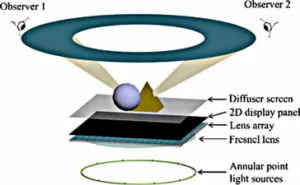A team of researchers headed by Sen-Lin Pang of the College of Electronics and Information Engineering at Sichuan University (Chengdu, China) is developing an innovative integral imaging display system.

First, a few words of background information on integral imaging technology paraphrased from Wikipedia.
Integral imaging is an autostereoscopic 3D imaging technique that captures and then reproduces a light field by using a 2D array of microlenses. In the capture mode, a detector is coupled to a microlens array. Each microlens allows acquisition of an image of the subject as seen from the viewpoint of that lens’s location. In the reproduction mode, an object or source array is coupled to the microlens array. Each microlens allows each observing eye to see only the area of the associated micro-image containing the portion of the subject that would have been visible through that space from that eye’s location.
The result is a visual reproduction complete with all significant depth cues including parallax in all directions and perspective that changes with the position and distance of the observer. The effect is so real that it can even induce visual accommodation. The image points perceived through the microlens array are virtual and have only a subjective location in space, allowing a scene of infinite depth to be displayed without resorting to an auxiliary, large magnifying lens or mirror.
The starting point for the approach developed by the researcher are the observations that, when viewers sit around a table to observe 3D images, the directions of view are generally oblique and that the best arrangement for the viewpoints would be in an annulus.
A recent article by the team presenting their latest developments on this topic is entitled “Tabletop integral imaging 3D display system based on annular point light source.” It is to publish in Displays, Volume 69, September 2021, 102029. A copy of the article is available for purchase on-line and can be found here.
As discussed in this paper, the configuration of the system consists of annular point light sources, a Fresnel lens, a lens array, a 2D display panel and a diffuser screen. The configuration of the system developed by the researchers is illustrated in the figure below.
The configuration of the integral imaging system developed by the research team.
Given this configuration, each point light source illuminates the Fresnel lens to form beams of parallel light and then illuminates the lens array and the display panel. By this means, a viewing sub-area is generated at the position of the diffuser screen in which the 3D images can be viewed. Multiple viewing sub-areas are created utilizing time division multiplexing to form a 360 degree annular viewing area.
In contrast with prior art tabletop 3D display systems, the 3D image produced by the new system can be presented to multiple viewers and is in a desired form: an annular viewing area that has an oblique viewing direction with respect to the tabletop.
The researchers conclude their article with the statement that “The experimental results demonstrate the feasibility of the tabletop integral imaging 3D display system.” -Arthur Berman
Beihang University, Yan Xing, [email protected]


